A far-off asteroid brought to life in 3D
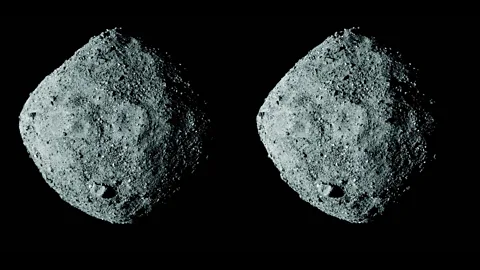 Brian May and Claudia Manzoni
Brian May and Claudia ManzoniThe asteroid Bennu is one of the most likely objects to collide with Earth – and a time capsule from the Solar System's early days. Nasa's Osiris-Rex mission has captured it in never-before-seen detail.
 Getty Images
Getty ImagesOn Sunday (24 September) a small capsule crashed down onto the Utah desert, in the US, after travelling billions of miles across our Solar System. Inside were tiny fragments from a rocky asteroid some 525m (1,722ft) across called "101955 Bennu". It is only the third time in history that material from an asteroid has been gathered and returned to Earth.
The capsule – filled with an estimated 250g (9oz) worth of rocks and dust – was released into the atmosphere and parachuted to the ground from Nasa’s Osiris-Rex spacecraft. The craft's multi-year trip to the asteroid was the US's first sample-return mission of its kind, and scientists hope its results will shed light on the mysterious origins of life – as well as on the threat posed by Bennu's potential collision-course with our planet.
The team also enlisted the help of an English rock guitarist, whose lifelong interest in both outer space and 3D-imaging techniques helped the capsule find a safe landing site on Bennu's surface: Queen's Sir Brian May.
(This gallery contains images which can create 3D images with the aid of a 3D viewer or the cross-eyed viewing effect.)
 Getty Images
Getty ImagesBennu was first discovered by telescope in 1999. Six years later, it was chosen as a candidate for a Nasa mission to recover asteroid samples and return them to Earth for detailed study.
Lockheed Martin Space Systems built the Osiris-Rex spacecraft which carried out the mission. The craft was designed to orbit the asteroid taking images and then descend to the surface, where a special robotic arm would use gas to stir up Bennu's surface and collect particles of dust and rock.
The entire cost of the seven-year mission – minus that of the Atlas rocket required to launch it – was more than $870m (£707m).
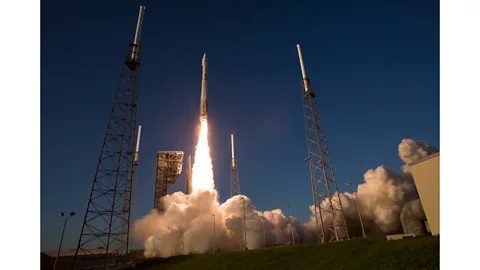 Getty Images
Getty ImagesOsiris-Rex launched on 8 September 2016 from Nasa's Cape Canaveral base in Florida. It spent nearly two years hurtling through space before arriving at Bennu.
On 31 December 2018, the spacecraft began mapping the asteroid from a distance of about 1.75km (1.09 miles) away, the closest any spacecraft has orbited around a celestial object. The spacecraft's cameras then studied the pockmarked surface of Bennu, looking for possible places for Osiris-Rex to collect material.
 Brian May and Claudia Manzoni
Brian May and Claudia ManzoniThe mission's lead investigator, Dante Lauretta from the University of Arizona in Tucson, then got an offer of help from an unlikely source: Queen guitarist Sir Brian May. An astrophysicist with an interest in stereo photography, Sir Brian and his colleague Claudia Manzoni had already created stereo composite from pictures taken by Nasa astronauts during the Apollo mission.
By combining images taken by Osiris-Rex, Sir Brian and Manzoni were able to create three-dimensional visuals of Bennu's surface. This in turn helped the team identify which sites were clear enough for the spacecraft to descend and which were too hazardous to approach. Eventually one – dubbed Nightingale – was chosen.
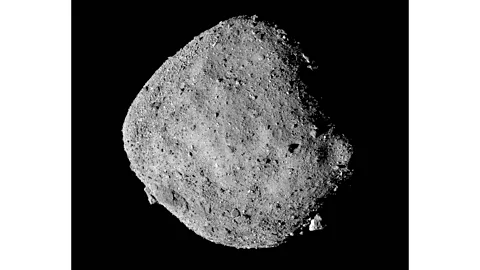 Nasa
NasaBennu is more than just a cold, coal-black rock gliding through our near space; it is thought to have formed 4.6 billion years ago, making it almost as old as the Solar System itself.
Likely broken off from a much larger asteroid some 700 million to two billion years ago, scientists believe Bennu may be home to similar organic molecules to those which helped seed life on Earth.
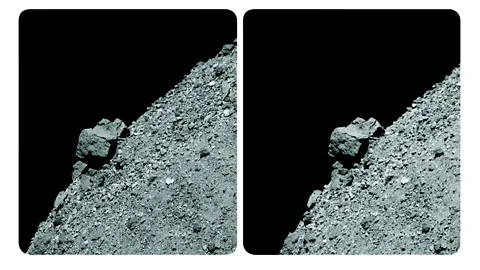 Brian May and Claudia Manzoni
Brian May and Claudia ManzoniPlus, there is also a more future-focussed reason scientists are keen to learn more about this particular asteroid: it's thought the mountainous object has a one-in-2,700 chance of colliding with Earth in the late 22nd Century.
Bennu passes close to Earth once every six years. Knowing more about its composition could allow future generations to better understand how to stop it should Bennu be on a collision course with the planet.
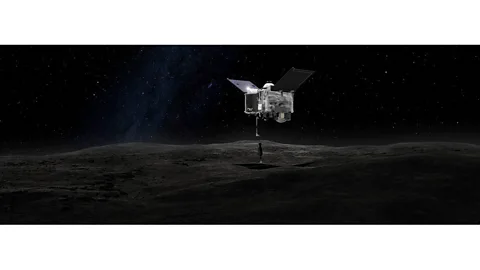 Nasa
NasaAfter two years in orbit analysing the asteroid's surface, Osiris-Rex touched down on Bennu on 20 October 2020; it was only 0.9m (3ft) from the target site its operators on Earth had chosen. The spacecraft's robotic arm punched though the asteroid's surface – which gave way with surprising ease – and squirted nitrogen gas to send up clouds of material, some of which was gathered into the Sample Return Capsule.
Osiris-Rex's four-year journey to Bennu's surface culminated in contact which lasted just six seconds. Osiris-Rex activated its thrusters and headed back into space; it would return to Earth to deliver the Sample Return Capsule, and then depart once more to explore further reaches of the Solar System.
The journey home would take two-and-a-half years.
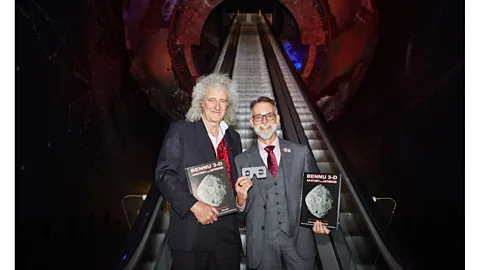
Even before the samples returned to Earth, the story of the mission's progress was published in a book written by Sir Brian and Dante Lauretta, seen here at the launch event in London's Science Museum in July.
Meanwhile, Osiris-Rex drew ever closer, carrying its capsule with its precious material gathered from Bennu.
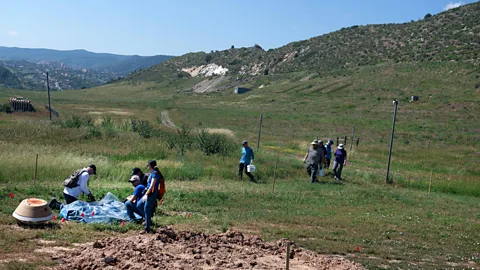 Getty Images
Getty ImagesLauretta and his team rehearsed the recovery of the capsule at a Lockheed Martin facility in Colorado. The samples had to remain sealed until they could be opened in a "clean room", to ensure they weren't contaminated by material here on Earth.
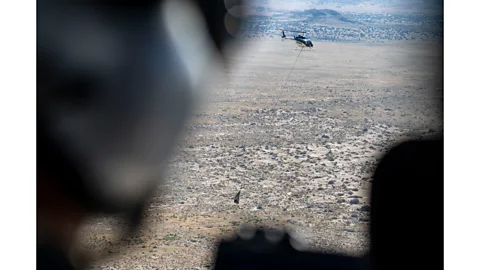 Getty Images
Getty ImagesOn Sunday, the Sample Return Capsule landed in Utah's West Desert at 8:52am local time, three minutes ahead of schedule.
It had entered Earth's atmosphere at 12m/s (27,000mph) but a combination of its heatshield and heavy-duty parachute slowed it to a safe speed. "It touched down like a feather," said Tim Priser, the chief engineer at Lockheed Martin.
The capsule was quickly loaded into a net slung underneath a helicopter and ferried to a nearby clean room in the Department of Defence’s Utah Test and Training Range – the first stage of the months and years of study of samples gathered in a few seconds, billions of miles away.
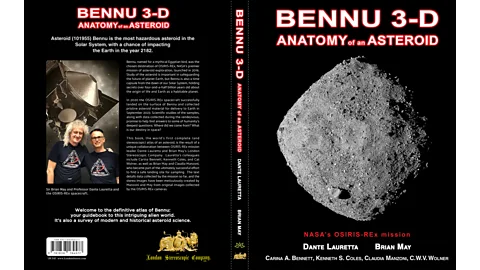 London Stereoscopic Company
London Stereoscopic CompanySome of the stereo images created from Osiris-Rex's photographs are from Bennu: Anatomy of an Asteroid, written by Sir Brian May and Dante Lauretta, and published by the London Stereoscopic Company.
